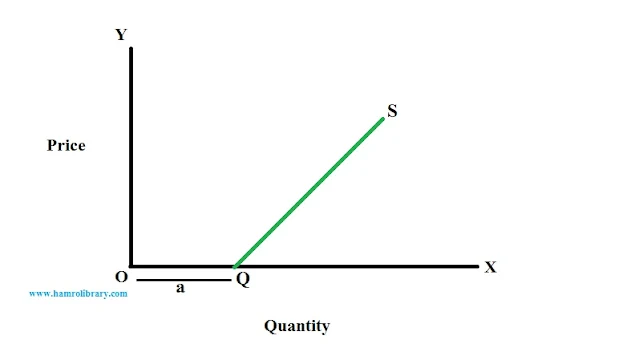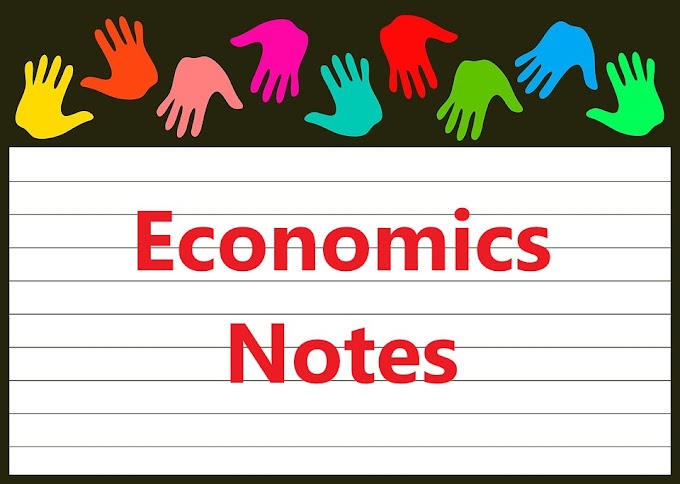Meaning of supply
Supply means the quantities of a commodity that its producer or seller is ready to offer for a sale at a given price and period of time. Just as demand implies a willingness and ability to pay, in the same manner, the phrase "ready to offer for sale" in the definition of supply given above implies both willingness and ability to deliver the goods.In general, more goods are offered for sale at a higher price, i.e., supply increases with the increase in price. Therefore, the relation between price and quantity supplied is positive and direct.
In the words of Prof. Thomas, "The supply of goods is the quantity offered for sale in a given market at a given time at various prices."
According to R.G, Lipsey, "The amount of a commodity that firms are able and willing to offer for sale is called the quantity supplied of that commodity."
Thus, the quantities of a good that an individual firm is willing and able to offer in sale over a given time period is defined as the supply.
Exceptions to the Law of Supply
Like the law of demand, there are some exceptions to the law of supply. They are:1. Expected price: When the price is expected to fall much, sellers sell more even at the lower price in order to clear their stocks. When the price is expected to rise in the future, sellers sell less even at a higher price in the present time.
2. Change in other factors: Change in habit, taste, fashion weather and national and international disturbances also affect the supply of a commodity.
3. Agricultural goods: The supply of agricultural goods more depends upon natural factors rather than the pricé of the commodity. For example, natural disaster like flood reduces the supply of paddy.
4. Perishable goods: Sellers want to sell more units of perishable goods although their prices may be falling because the sellers can not hold perishable goods.
5. Auction sale: When a firm wants to sell its old stock, it sells through an auction sale. In the case of auction sales, sellers sell more goods at a reduced price. The motive behind such a sale is to clear off old stock.
Determinants of Supply
The supply of a commodity depends upon many factors. Factors determining the supply of a commodity are known as determinants of supply. The most important determinants of supply are as follows:1. Price of the commodity: The price of the commodity is the most important determinant of supply. There is a direct relationship between the price of the commodity and its quantity supplied, other things remaining the same. It means that at the higher price, producers or sellers offer more quantity of a commodity for sale, and at a lower price, producers or sellers offer less quantity of the commodity for sale.
2. The price of the other goods: The supply of a particular commodity is inversely related to the price of other commodities. For example, a rise in the price of rice will fall the supply of wheat. This is due to the fact that a rise in the price of rice will encourage producers to produce more rice.
3. The price of the factors of production: The supply of a commodity is also affected by the price of factors of production. With the rise in the price of factors of production, the cost of production also rises, which results in a decrease in supply and vice versa.
4. Goal of the firm: If the goal of the firm is to maximize profit, less quantity of the commodity will be offered for sale at a high price. On the other hand, if the goal of the firm is to maximize sales or revenue or maximize output or employment, more will be supplied even at the lower price.
5. Improvement in technology: Improvement in technology has a positive effect on the supply of the commodity. It reduces the per-unit cost of production. Consequently, the profit of the business firm will increase. In order to earn more profit, firms increase the supply of the commodity.
6. Government policy: Taxation and subsidy policies of the government also affect the market supply of the commodity. An increase in taxation tends to reduce the supply, while subsidies tend to induce a greater supply of the commodity.
7. Expected future price: If the producers expect a rise in the price of the commodity in the near future, the current supply of the commodity decreases. On the other hand, if they expect a fall in the price, the current supply increases.
8. Number of firms: The market supply of a commodity also depends upon the number of firms in the market. An increase in the number of firms implies an increase in market supply. A decrease in the number of firms implies a decrease in the market supply of a commodity.
9. Development of infrastructure: The supply of the commodity depends on available facilities of infrastructure such as transport and communication, electricity, etc. The producer can supply more quantity of the product with the proper development of such infrastructures and vice-versa.
10. Natural factors: Favorable natural factors such as adequate rainfall help to boost up agricultural production, which leads to an increase in supply. On the other hand, unfavorable natural factors like drought, heavy rainfall, storm, flood,s, etc hinder the production of agricultural production, which leads to a decrease in supply.
Click here to learn about "The law of Supply."
Supply function
The supply function is defined as the functional relationship between the supply of a commodity and its various determinants. It is expressed as:Qx = f(Px, Py, Pf, T, t, G, ...}
Where,
Qx = supply of commodity X
f = functional relation
Qx = supply of commodity X
f = functional relation
Px = price of commodity X
Py = price of other goods
Pf = price of factors of production
Py = price of other goods
Pf = price of factors of production
G = goals of the producer
T = state of technology
T = state of technology
t = time
The supply function is based on the law of supply. The law of supply states the positive relationship between the price and the quantity supplied. Other remaining the same, it may be expressed as
Qx = f(Px)
The supply function is based on the law of supply. The law of supply states the positive relationship between the price and the quantity supplied. Other remaining the same, it may be expressed as
Qx = f(Px)
Where,
Qx = quantity supplied of commodity X
Px = price of commodity X
It means that the quantity supplied of a commodity is a function of the price of that commodity.
Qx = quantity supplied of commodity X
Px = price of commodity X
It means that the quantity supplied of a commodity is a function of the price of that commodity.
Types of Supply Function
There are two types of supply function:
1. Linear Supply Function
If the slope of the supply curve remains constant throughout its length, it is called linear supply functions. In other words, if both dependents and independent variables like quantity supplied and price change at the constant rate, supply function or supply curve will be linear. The linear supply function can be expressed as follows:
Qx = a + bPx
Where,
Qx = Quantity supplied of commodity X
a = X- intercept or autonomous supply or quantity supplied at zero price
b = Slope of the supply curve
Px = Price of the commodity X.
The following supply curve represents linear supply function or linear supply curve:

In the above figure, QS represents the linear supply curve. In other words, represents a linear supply function. The X intercept made by the supply curve is ‘a’. It means that the quantity supplied at zero price is equal to OQ.
2. Non-linear Supply function
If the slope of the supply curve changes along the supply curve, it is called a non-linear supply function. In other words, if both the dependent variable and independent variables change at different rates, the supply function is called a non-linear supply function. It represents a nonlinear supply curve. The non-linear supply function is expressed as follows:
Qx = a(Px)៱b
Where,
Qx Quantity supplied of commodity X.
a = Intercept or autonomous supply or quantity supplied at zero price
b = Slope of the supply curve.
Px = Price of the commodity X
The following supply curve SS represents a non-linear supply function or nonlinear supply curve.
The following supply curve SS represents a non-linear supply function or nonlinear supply curve.

.jpeg)

.jpeg)






If this article has helped you, please leave a comment.